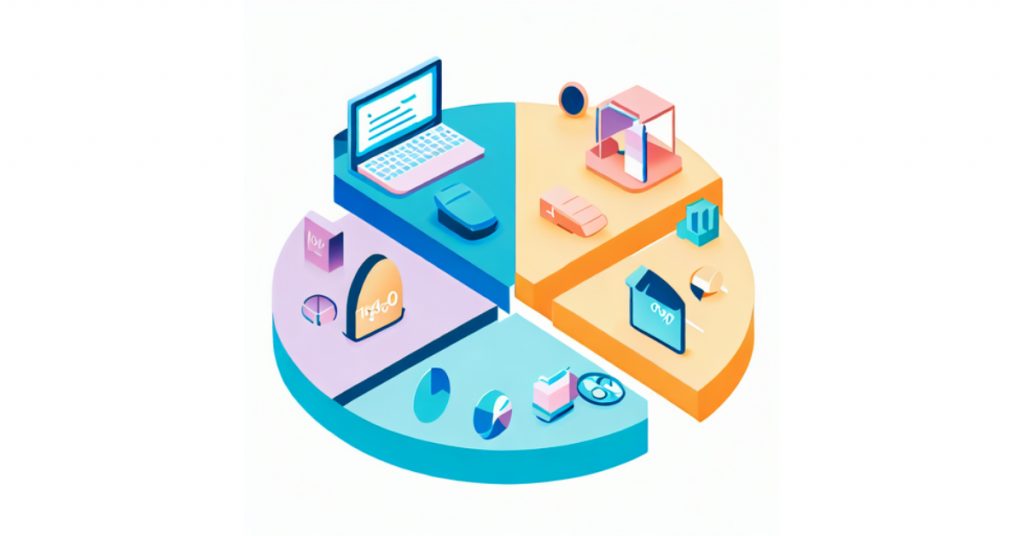Have you ever dreamed of being your own boss, setting your own schedule, and working from anywhere in the world? If so, you’re not alone. Millions of people share the same vision of freedom, flexibility, and fulfillment that comes with online entrepreneurship.
But what is online entrepreneurship exactly? And how can you get started on this exciting and rewarding journey?
Online entrepreneurship is the art and science of creating and running a business on the internet. It’s a way of turning your passion, skills, or ideas into products or services that solve real problems for real people.
Online entrepreneurship is also a way of living your best life, according to your own terms and values. It’s a way of expressing your creativity, challenging yourself, and making a positive impact on the world.
Sounds amazing, right? But how do you become an online entrepreneur?
Well, it’s not as easy as it sounds. Online entrepreneurship is not a game for the faint of heart. It requires hard work, dedication, patience, and perseverance. It requires courage, creativity, and adaptability. It requires sacrifice, risk, and uncertainty.
But don’t let that scare you away. Online entrepreneurship is also one of the most rewarding and fulfilling endeavors you can pursue. And the good news is that anyone can do it, as long as they have the right mindset, strategy, and tools.
In this guide, I will show you how to start an online business in 2023 in 10 simple steps. I will share with you the secrets and strategies that have helped me build my own online empire, and the mistakes and challenges that have taught me valuable lessons.
By following these steps, you will be able to create your own online business that suits your skills, passions, and goals. You will be able to reach and serve your ideal customers and generate income and impact from your online presence.
Are you ready to play the game of online business? If so, let’s begin.
Step 1: Choose Your Niche

The first step to starting an online business is to choose your niche. Your niche is the specific market or audience that you want to serve with your online business. It’s the group of people who share a common problem, need, desire, interest, or passion that you can help them with.
Choosing your niche is crucial because it will determine everything else about your online business: your product or service offering, your value proposition, your marketing strategy, your competition, your revenue potential, and more.
But how do you choose your niche?
The key is to find the sweet spot between three factors: profitability, popularity, and passion.
Profitability means that there is enough demand and money in your niche to sustain your online business. You want to choose a niche that has enough potential customers who are willing to pay for your solution.
Popularity means that there is enough interest and traffic in your niche to attract your online business. You want to choose a niche that has enough people who are searching for information or solutions related to your topic.
Passion means that you are genuinely interested and excited about your niche. You want to choose a niche that aligns with your knowledge base, skill set, and personality.
To find your niche sweet spot, you need to do some research and analysis. You need to find out what are the most profitable and popular niches in the online space, what are the gaps and opportunities in those niches that you can fill or exploit, what are the needs and wants of your target audience that you can satisfy or exceed, what are the unique skills or talents that you can leverage or showcase in those niches, and what are the passions or hobbies that you can enjoy or share in those niches.
To help you with this process, you can use tools like Google Trends1, Semrush2, or Keyword Tool3 to discover the most searched for topics, keywords, and trends in your niche. You can also use tools like Amazon4, Clickbank5, or Udemy6 to find out what are the most popular products or services in your niche. You can also use tools like Quora7, Reddit8, or Facebook Groups9 to find out what are the most common questions or problems that your target audience has in your niche.
Once you have done your research and analysis, you should be able to narrow down your niche to a specific sub-niche that is profitable, popular, relevant, satisfying, and enjoyable for you. For example, instead of choosing a broad niche like “health”, you can choose a sub-niche like “weight loss for busy moms”. Instead of choosing a generic niche like “travel”, you can choose a sub-niche like “solo travel for women”. Instead of choosing a vague niche like “personal development”, you can choose a sub-niche like “mindfulness meditation for beginners”.
Choosing a sub-niche will help you stand out from the crowd, attract more loyal customers, and create more value for them. It will also help you focus your efforts, resources, and time on what matters most for your online business success.
Step 2: Validate Your Niche
The second step to starting an online business is to validate your niche. Validation means testing and proving that your niche is viable, feasible, and desirable for your online business. It means making sure that there is enough demand, competition, and profitability in your niche before you invest too much time, money, and energy into it.
Validation is important because it will save you from wasting your resources on a niche that is too saturated, too narrow, too boring, or too difficult for your online business. It will also help you avoid the common mistake of creating a product or service that nobody wants, needs, or cares about.
To validate your niche, you need to do some experiments and surveys. You need to find out if there are enough people who are interested in your niche, if there are enough competitors who are successful in your niche, and if there are enough customers who are willing to pay for your product or service in your niche.
To help you with this process, you can use tools like Google Ads, Facebook Ads, or Instagram Ads to run some low-cost ads to test the demand and interest in your niche. You can also use tools like SurveyMonkey, Typeform, or Google Forms to create some simple surveys to ask your target audience about their problems, needs, desires, preferences, and feedback in your niche. You can also use tools like Shopify, Gumroad, or Teachable to create some landing pages or sales pages to pre-sell your product or service in your niche.
Once you have done your experiments and surveys, you should be able to validate your niche with some concrete data and evidence. You should be able to see if there is enough traffic, engagement, conversion, and revenue in your niche to justify your online business idea. You should also be able to see if there is enough positive feedback, testimonials, and reviews in your niche to support your online business value proposition.
Validating your niche will help you reduce the risk and uncertainty of your online business, increase the confidence and credibility of your online business, and optimize the performance and profitability of your online business.

Step 3: Define Your Brand
The third step to starting an online business is to define your brand. Your brand is the identity and personality of your online business. It’s the name, logo, slogan, color scheme, tone of voice, story, mission, vision, values, and culture of your online business. It’s what makes your online business unique, memorable, and recognizable among your customers and competitors.
Defining your brand is essential because it will help you create a strong and consistent image for your online business, build a loyal and engaged community around your online business, and differentiate yourself from other online businesses in your niche.
But how do you define your brand?
The key is to find the essence of what makes you and your online business special. You need to find out what are the core values and beliefs that drive you and your online business, what are the unique benefits and features that you and your online business offer, what are the emotional connections and associations that you and your online business create, and what are the stories and experiences that you and your online business share.
To help you with this process, you can use tools like Namecheap, GoDaddy, or Domain.com to check the availability and register the domain name for your online business. You can also use tools like Canva, LogoMaker, or Hatchful to create the logo for your online business. You can also use tools like Shopify Slogan Maker, Oberlo Slogan Generator, or Sloganizer.net to generate some slogans for your online business. You can also use tools like Coolors, Adobe Color, or Paletton to pick some colors for your online business. You can also use tools like Hemingway Editor, Grammarly, or ProWritingAid to improve the tone of voice for your online business. You can also use tools like StoryBrand Framework, Pixar Storytelling Formula, or Hero’s Journey Template to structure the story for your online business.
Once you have done this process, you should be able to define your brand with a clear and compelling vision.
Step 4: Create Your Product or Service
The fourth step to starting an online business is to create your product or service. Your product or service is the solution that you offer to your target audience to solve their problem, satisfy their need, fulfill their desire, or enhance their interest or passion.
Creating your product or service is vital because it will determine the value and quality of your online business, the satisfaction and loyalty of your customers, and the revenue and profit of your online business.
But how do you create your product or service?
The key is to find the best format and delivery method for your solution. You need to find out what are the most suitable and effective ways to present and provide your solution to your target audience, based on their preferences, expectations, and behaviors.
To help you with this process, you can use tools like Google Analytics, Hotjar, or Crazy Egg to track and analyze the behavior and feedback of your website visitors. You can also use tools like Google Forms, Typeform, or SurveyMonkey to create some simple surveys or quizzes to ask your target audience about their preferences and expectations for your product or service. You can also use tools like Skype, Zoom, or Calendly to schedule some interviews or consultations with your target audience to get some direct and personal insights into their needs and wants for your product or service.
Once you have done this process, you should be able to create your product or service with a clear and compelling value proposition. You should be able to choose the best format and delivery method for your solution, such as:
- A physical product that you can sell online through platforms like Shopify, WooCommerce, or Amazon.
- A digital product that you can sell online through platforms like Gumroad, Teachable, or Clickbank.
- A service that you can offer online through platforms like Fiverr, Upwork, or Freelancer.
- A subscription that you can offer online through platforms like Patreon, Substack, or Memberful.
- A membership that you can offer online through platforms like Kajabi, Podia, or Mighty Networks.
Creating your product or service will help you deliver value and quality to your customers, satisfy their needs and wants, and generate income and impact from your online business.
Step 5: Launch Your Product or Service
The fifth step to starting an online business is to launch your product or service. Launching your product or service is the process of introducing and promoting your solution to your target audience and the world. It’s the process of getting your first customers, feedback, and sales for your online business.
Launching your product or service is crucial because it will help you validate and improve your solution, build trust and credibility for your online business, and grow your audience and revenue for your online business.
But how do you launch your product or service?
The key is to find the best strategy and channel for your launch. You need to find out what are the most effective and efficient ways to reach and attract your target audience, what are the most compelling and persuasive ways to communicate and demonstrate your value proposition, and what are the most optimal and profitable ways to price and sell your solution.
To help you with this process, you can use tools like Google Ads, Facebook Ads, or Instagram Ads to run some paid ads to drive traffic and conversions for your product or service. You can also use tools like Mailchimp, ConvertKit, or AWeber to build an email list and send some email campaigns to nurture and convert your leads into customers. You can also use tools like WordPress, Medium, or LinkedIn to create some blog posts and articles to educate and inform your audience about your product or service. You can also use tools like YouTube, Vimeo, or Wistia to create some videos and webinars to showcase and explain your product or service. You can also use tools like Twitter, Facebook, or Instagram to create some social media posts and stories to engage and entertain your audience about your product or service.
Once you have done this process, you should be able to launch your product or service with a clear and powerful message. You should be able to choose the best strategy and channel for your launch, such as:
- A pre-launch that you can use to build anticipation and excitement for your product or service before it goes live.
- A soft launch that you can use to test and refine your product or service with a small group of early adopters before it goes public.
- A hard launch that you can use to announce and release your product or service to the masses with a big bang.
- A rolling launch that you can use to gradually introduce and improve your product or service over time with constant updates and feedback.
Launching your product or service will help you validate and improve your solution, build trust and credibility for your online business, and grow your audience and revenue for your online business.

Step 6: Build Your Website
The sixth step to starting an online business is to build your website. Your website is the online home and storefront of your online business. It’s the place where you showcase and sell your product or service, as well as communicate and connect with your audience.
Building your website is important because it will help you establish and enhance your online presence, credibility, and authority. It will also help you attract and convert more visitors into customers, as well as retain and delight your existing customers.
But how do you build your website?
The key is to find the best platform and tool for your website. You need to find out what are the most suitable and user-friendly options to create and manage your website, based on your budget, skill level, and needs.
To help you with this process, you can use tools like WordPress, Squarespace, or Wix to create and customize your website with ease and flexibility. You can also use tools like Elementor, Divi, or Thrive Architect to design and edit your website with drag-and-drop features and templates. You can also use tools like Yoast SEO, Google Analytics, or OptinMonster to optimize and improve your website for SEO, analytics, and conversions.
Once you have done this process, you should be able to build your website with a clear and attractive design and layout. You should be able to choose the best platform and tool for your website, such as:
- A self-hosted WordPress website that gives you full control and ownership of your website, as well as access to thousands of plugins and themes to enhance your website functionality and appearance.
- A hosted Squarespace website that gives you a simple and elegant solution for your website, as well as access to a range of features and integrations to streamline your website creation and management.
- A hosted Wix website that gives you a fast and easy way to create your website, as well as access to a variety of tools and apps to boost your website performance and experience.
Building your website will help you establish and enhance your online presence, credibility, and authority. It will also help you attract and convert more visitors into customers, as well as retain and delight your existing customers.
Step 7: Grow Your Audience
The seventh step to starting an online business is to grow your audience. Your audience is the group of people who are interested in your niche, aware of your online business, and engaged with your content. They are the potential customers who can become loyal fans and advocates of your online business.
Growing your audience is essential because it will help you increase the reach and visibility of your online business, build trust and rapport with your audience, and generate more traffic and leads for your online business.
But how do you grow your audience?
The key is to find the best strategy and channel for your audience growth. You need to find out what are the most effective and efficient ways to reach and attract more people who are interested in your niche, what are the most compelling and valuable ways to communicate and deliver your content to them, and what are the most optimal and sustainable ways to nurture and retain them.
To help you with this process, you can use tools like Mailchimp, ConvertKit, or AWeber to build an email list and send some email campaigns to nurture and convert your leads into customers. You can also use tools like WordPress, Medium, or LinkedIn to create some blog posts and articles to educate and inform your audience about your product or service. You can also use tools like YouTube, Vimeo, or Wistia to create some videos and webinars to showcase and explain your product or service. You can also use tools like Twitter, Facebook, or Instagram to create some social media posts and stories to engage and entertain your audience about your product or service.
Once you have done this process, you should be able to grow your audience with a clear and powerful message. You should be able to choose the best strategy and channel for your audience growth, such as:
- An email marketing strategy that helps you build a direct and personal relationship with your audience, as well as deliver relevant and valuable content to them on a regular basis.
- A content marketing strategy that helps you establish yourself as an expert and authority in your niche, as well as provide useful and informative content to them on various platforms.
- A video marketing strategy that helps you showcase yourself as a personable and trustworthy online entrepreneur, as well as demonstrate the benefits and features of your product or service on different channels.
- A social media marketing strategy that helps you connect with yourself as a relatable and authentic online entrepreneur, as well as share stories and experiences of yourself or others related to your product or service on various networks.
Growing your audience will help you increase the reach and visibility of your online business, build trust and rapport with your audience, and generate more traffic and leads for your online business.
Step 8: Monetize Your Audience
The eighth step to starting an online business is to monetize your audience. Monetizing your audience is the process of turning your audience into customers, and customers into repeat buyers. It’s the process of generating income and profit from your online business.
Monetizing your audience is important because it will help you sustain and grow your online business, as well as reward you for your hard work and value creation. It will also help you achieve your financial and personal goals, as well as make a positive impact on the world.
But how do you monetize your audience?
The key is to find the best strategy and model for your monetization. You need to find out what are the most suitable and profitable ways to charge and collect money from your customers, what are the most appealing and persuasive ways to present and offer your product or service to them, and what are the most optimal and scalable ways to deliver and support your product or service to them.
To help you with this process, you can use tools like Stripe, PayPal, or Square to accept and process payments from your customers. You can also use tools like ThriveCart, SamCart, or ClickFunnels to create and optimize your sales pages and funnels for your product or service. You can also use tools like Zendesk, Intercom, or Help Scout to provide and manage customer service and support for your product or service.
Once you have done this process, you should be able to monetize your audience with a clear and attractive value proposition. You should be able to choose the best strategy and model for your monetization, such as:
- A one-time payment model that allows you to charge a fixed amount for your product or service once per customer.
- A recurring payment model that allows you to charge a recurring amount for your product or service on a regular basis per customer.
- A freemium model that allows you to offer a free version of your product or service with limited features or functionality, and charge for a premium version with more features or functionality per customer.
- A commission model that allows you to earn a percentage of the sales or revenue generated by promoting other people’s products or services as an affiliate per customer.
Monetizing your audience will help you sustain and grow your online business, as well as reward you for your hard work and value creation. It will also help you achieve your financial and personal goals, as well as make a positive impact on the world.

Step 9: Scale Your Online Business
The ninth step to starting an online business is to scale your online business. Scaling your online business is the process of increasing and expanding the reach, impact, and revenue of your online business. It’s the process of growing your online business beyond its current limits and potential.
Scaling your online business is essential because it will help you leverage and optimize your online business resources, systems, and processes. It will also help you serve more customers, create more value, and generate more income and profit from your online business.
But how do you scale your online business?
The key is to find the best strategy and method for your scaling. You need to find out what are the most effective and efficient ways to automate and delegate the tasks and operations of your online business, what are the most suitable and beneficial ways to partner and collaborate with other online entrepreneurs or businesses, and what are the most innovative and creative ways to diversify and expand your product or service portfolio.
To help you with this process, you can use tools like Zapier, IFTTT, or Automate.io to automate some of the repetitive and mundane tasks of your online business. You can also use tools like Asana, Trello, or Slack to delegate some of the complex and time-consuming tasks of your online business. You can also use tools like JVZoo, WarriorPlus, or Clickbank to partner with other online entrepreneurs or businesses who have complementary products or services or audiences. You can also use tools like Product Hunt, Kickstarter, or Indiegogo to launch new products or services that cater to new markets or niches.
Once you have done this process, you should be able to scale your online business with a clear and ambitious vision. You should be able to choose the best strategy and method for your scaling, such as:
- An automation strategy that helps you save time and money by using software or tools to perform some of the tasks of your online business.
- A delegation strategy that helps you save energy and stress by hiring or outsourcing some of the tasks of your online business.
- A partnership strategy that helps you increase exposure and revenue by working with other online entrepreneurs or businesses who have complementary products, services, or audiences.
- A diversification strategy that helps you increase value and profit by creating new products, services, or markets for your online business.
Scaling your online business will help you leverage and optimize your online business resources, systems, and processes. It will also help you serve more customers, create more value, and generate more income and profit from your online business.
Step 10: Enjoy Your Online Business
The tenth and final step to starting an online business is to enjoy your online business. Enjoying your online business is the process of celebrating and appreciating the achievements and rewards of your online business. It’s the process of living your best life, according to your own terms and values.
Enjoying your online business is important because it will help you maintain and improve your motivation, passion, and happiness for your online business. It will also help you balance and harmonize your personal and professional life, as well as contribute and give back to the world.
But how do you enjoy your online business?
The key is to find the best way and time for your enjoyment. You need to find out what are the most meaningful and satisfying ways to celebrate and appreciate your online business success, what are the most enjoyable and fulfilling ways to live and work with your online business, and what are the most generous and impactful ways to share and donate your online business wealth.
To help you with this process, you can use tools like Calendly, Google Calendar, or Outlook to schedule some time for yourself and your loved ones to relax and have fun. You can also use tools like Spotify, Netflix, or Audible to enjoy some music, movies, or books that inspire and entertain you. You can also use tools like Kiva, GiveWell, or Charity Navigator to find and support some causes or organizations that resonate with you.
Once you have done this process, you should be able to enjoy your online business with a clear and grateful mind. You should be able to choose the best way and time for your enjoyment, such as:
- A celebration that helps you acknowledge and appreciate your online business achievements and rewards, such as a party, a vacation, or a gift.
- A lifestyle that helps you live and work with your online business, such as a flexible schedule, a comfortable environment, or a healthy routine.
- A contribution that helps you share and donate your online business wealth, such as a donation, a sponsorship, or a mentorship.
Enjoying your online business will help you maintain and improve your motivation, passion, and happiness for your online business. It will also help you balance and harmonize your personal and professional life, as well as contribute and give back to the world.

Conclusion
Starting an online business in 2023 is not a game for the faint of heart. It requires hard work, dedication, patience, and perseverance. It requires courage, creativity, and adaptability. It requires sacrifice, risk, and uncertainty.
But starting an online business in 2023 is also one of the most rewarding and fulfilling endeavors you can pursue. It offers freedom, flexibility, and fulfillment. It offers value, quality, and impact. It offers income, profit, and wealth.
If you are ready to play the game of online business in 2023, follow these 10 simple steps:
- Choose Your Niche
- Validate Your Niche
- Define Your Brand
- Create Your Product or Service
- Launch Your Product or Service
- Build Your Website
- Grow Your Audience
- Monetize Your Audience
- Scale Your Online Business
- Enjoy Your Online Business
By following these steps, you will be able to create your own online business that suits your skills, passions, and goals. You will be able to reach and serve your ideal customers and generate income and impact from your online presence.
You will also be able to enjoy the freedom and flexibility of working from anywhere, anytime, and on your own terms.
Are you ready to start your online business in 2023? If so, don’t wait any longer. Take action today and make your dream a reality.
And remember winter is coming. But so is spring. And summer. And autumn. And winter again.
The game of online business never ends. But neither does the game of life.
So play it well. And enjoy it.
I hope you enjoyed this guide on how to start an online business in 2023. If you have any questions or feedback, please let me know in the comments below. I would love to hear from you.😊
And if you want to learn more about online entrepreneurship and digital marketing from me, please subscribe to my email list below. I will send you some exclusive tips and tricks on how to grow your online business faster and easier.
Thank you for reading this guide. I wish you all the best in your online business journey.
This is Lewis Anderson signing off.
Stay awesome. Stay curious. Stay hungry.


Leave a Reply